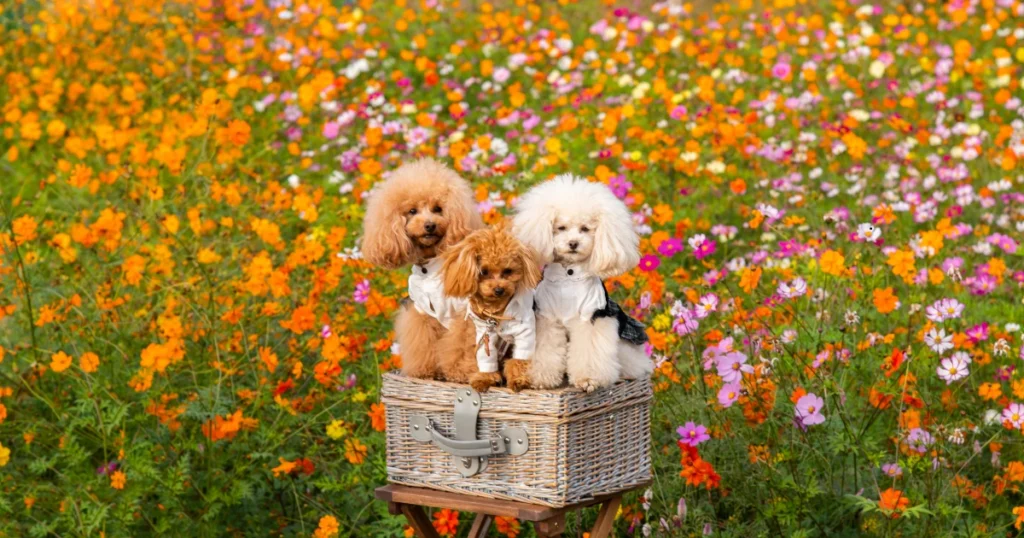
Welcome to your comprehensive toy poodle training and care guide for beginners. This guide will help you understand everything about raising a happy, healthy toy poodle. Whether you are considering getting a toy poodle or already have one, this guide covers all essential aspects of toy poodle ownership.
Why Are Toy Poodles Great Dogs?
Toy Poodles are not only adorable but also versatile and adaptable. They are excellent companions due to their:
Intelligence: Renowned for their problem-solving skills and trainability, Toy Poodles excel in obedience and agility training.
Loyalty: These dogs are dependable and loving pets because of their deep attachment to their families.
Adaptability: They thrive in various environments, from apartments to larger homes.
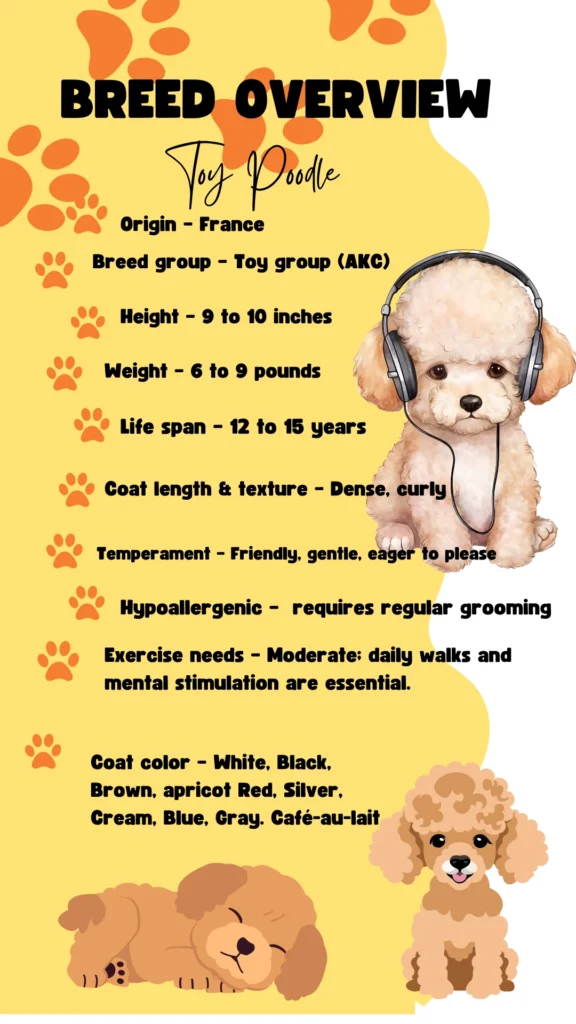
Understanding Your Toy Poodle
The toy poodle training and care guide for beginners starts with understanding this unique breed. Toy poodles stand approximately 10 inches tall and weigh between 6 to 9 pounds. These elegant dogs combine intelligence with a loving personality, making them perfect companions for various households.
Intelligence and Size Comparisons
Understanding Breed Differences
- Toy Poodles share identical intelligence levels with Standard Poodles.
- “Teacup Poodle” is a marketing term, not an official size—avoid breeders using this term.
- Miniature Poodles (10-15 inches) differ only in size from Toy Poodles (under 10 inches), not in intelligence or temperament.
Training Difficulty Level
A key question in any toy poodle training and care guide for beginners is: “Is a toy poodle easy to train?” The answer is yes. Toy poodles are among the most trainable dog breeds due to their:
- High intelligence level—they can learn new commands in under 5 repetitions.
- Eager-to-please nature
- Strong food motivation
- Quick problem-solving abilities
- Excellent memory retention
However, successful training requires:
- Consistency in commands
- Positive reinforcement techniques
- Early socialization
- Regular practice sessions
- Patience during the learning process
Physical Characteristics
Before delving deeper into the toy poodle training and care guide for beginners, let’s first explore their distinctive features.
- Height: Approximately 10 inches at the shoulder
- Weight: 6 to 9 pounds when fully grown.
- Coat: Curly, hypoallergenic, continuously growing
- Colors: Black, white, apricot, silver, red, brown
- Lifespan: 12 to 15 years with proper care.
Care Difficulty Level
Many beginners ask, “Is a toy poodle easy to take care of?” Toy poodles require moderate maintenance:
Easy aspects
- Small size makes handling manageable
- Adaptable to different living situations
- No heavy exercise requirements
- Highly responsive to training
- Good indoor pets
Challenging aspects
- Regular professional grooming is needed.
- Daily coat maintenance is required.
- Needs consistent mental stimulation.
- Regular dental care is essential.
You can’t leave it alone for extended periods.
Essential Toy Poodle Training and Care Guide for Beginners: Initial Steps

Every new toy poodle owner should focus on these fundamental aspects:
Early Socialization
Your toy poodle training and care guide for beginners emphasizes early socialization as crucial. Start between 8-16 weeks by exposing your puppy to:
- Different people
- Various environments
- Other pets
- Different sounds
- New situations
Basic Training Fundamentals
This section of the toy poodle training and care guide for beginners covers essential training tips:
- Start with short sessions (5-10 minutes).
- Use positive reinforcement.
- Maintain consistency
- Focus on one command at a time.
- Reward good behavior immediately.
- Common behaviors and characteristics
- Shedding and grooming.
- Minimal shedding due to a single-layer coat
- Hair grows continuously rather than sheds.
- Regular grooming is necessary to control hair growth.
- Hypoallergenic qualities make them suitable for allergy sufferers. However, in some cases there may be a chance of having dandruff who has extremely sensitive skin.
You can also watch How to Train your Poodle? [Easy Yet Most Effective Method] on YouTube or watch below:
Behavioral Traits
- Follow owners due to strong attachment and pack mentality.
- Need 2-4 hours of direct attention daily.
- Sleep for 12–14 hours per day.
- Generally quiet, rarely howling.
- When properly socialized, they typically get along well with cats.
- Standard poodles inherit their natural swimming ability.
- Typically, they don’t have strong body odor when properly groomed.
Potential Behavior Issues
- May chew furniture if under-stimulated
- Lack of proper training can lead to the development of separation anxiety.
- Excessive following or clinginess requires early boundary training.
- Destructive behavior often indicates a lack of exercise or mental stimulation.
Daily Activity Pattern
- Morning: Most active
- Afternoon: Rest periods
- Evening: Moderate activity
- Night: Sleep for 8–10 hours.
- Short naps throughout the day: 2–4 hours total.
Complete Training Guide
For those wondering “How to take care of a poodle for beginners, this toy poodle training and care guide for beginners provides detailed information about all aspects of training.
When to start training?
Start training your toy poodle as early as possible:
- Basic commands: 8 weeks old
- Socialization: 8-16 weeks
House training should begin as soon as the puppy is brought home.
- Crate training: First day at home
- Leash training: 8 to 10 weeks
Behavioral training: Ongoing from day one
House Training Guide
Many ask, “Are toy poodles hard to house train?” Can I potty-train my toy poodle? Toy poodles are generally receptive to house training when approached consistently.
House Training Timeline
- 8-12 weeks: Basic potty schedule establishment
- 3–4 months: growing bladder control
- 4–6 months: Increased reliability
- 6–8 months: usually fully house-trained
- 8+ months: occasional refinement is needed.
How to Potty Train a Toy Poodle Puppy
- Establish a strict schedule.
- Choose a designated potty area.
- Watch for signs (circling, sniffing).
- Use positive reinforcement.
- Maintain consistency
- Bathroom Schedule
- First thing in the morning,
- After meals
- After naps
- Before bedtime
- Every 2–3 hours for puppies.
- Every 4-6 hours for adults
Crate Training Guide
Here’s how to crate train a toy poodle puppy:
- Choose an appropriate size crate.
- Make the crate comfortable.
- Introduce gradually
- Use positive associations.
- Never use it as punishment.
- Walking and Exercise Guide
- Walking Schedule
- Puppies: 5 minutes per month of age, twice daily
- Adults: 20 to 30 minutes, twice daily.
- Seniors: 15-20 minutes, adjusted for health
- Exercise Requirements
- Daily walks
- Interactive play sessions
- Mental stimulation activities
- Training exercises
- Supervised yard time
Time Alone Management
How long can toy poodles stay alone?
- Puppies (under 6 months): 2–3 hours maximum
- Adults: 4-6 hours
- Seniors: 4-6 hours
- Never: More than 8 hours
Barking Management
Understanding Barking
Many ask, “Do toy poodles bark a lot?” People often inquire, “Do toy poodles bark excessively?” Toy poodles may bark for various reasons:
- Alert barking
- Attention-seeking
- Anxiety
- Boredom
- Territorial behavior
How to Stop a Toy Poodle from Barking
- Identify trigger
- Use positive reinforcement.
- Teach the “quiet” command.
- Provide mental stimulation
- Address underlying anxiety
- Barking Control Techniques
- Consistent commands
- Regular exercise
- Mental stimulation
- Professional training, if needed.
- Environmental management
Training Tips and Discipline
How to Train a Toy Poodle
- Use positive reinforcement.
- Keep sessions short.
- Be consistent.
- Practice regularly.
- Stay patient.
How to Discipline a Toy Poodle
- Never use physical punishment.
- Use positive reinforcement.
- Redirect unwanted behavior
- Be consistent with rules.
- Time-outs when needed
Setting Up for Success
Daily Routine
A structured day helps with training:
Morning:
- 6:00-7:00 AM: Wake up and potty break
- 7:00-7:30 AM: Breakfast
- 7:30-8:00 AM: Morning Walk
- 8:00-12:00 PM: Rest/play periods
Afternoon:
- 12:00-12:30 PM: Lunch and potty break
- 12:30-4:30 PM: Rest/play periods
- 4:30-5:00 PM: Afternoon walk
Evening:
- 5:00-6:00 PM: Dinner
- 6:00-9:00 PM: Family time/training
- 9:00-10:00 PM: Final potty break
Training Success Indicators
- Consistent bathroom habits
- Following basic commands
- Reduced barking
- Create comfort
- Walking well on leash.
Daily Care
- Brush coat for 10-15 minutes
- Provide fresh water
- Feed the scheduled meals.
- Exercise 20-30 minutes
- Clean the eye area
Weekly Care
- Clean ears
- Check for skin issues
- Brush teeth
- Deep coat brushing.
- Nail check
Monthly Care
- Professional grooming
- Nail trimming
- Health check
- Flea prevention
- Weight monitoring
Daily Care Requirements: How Much Food Does a Toy Poodle Need?
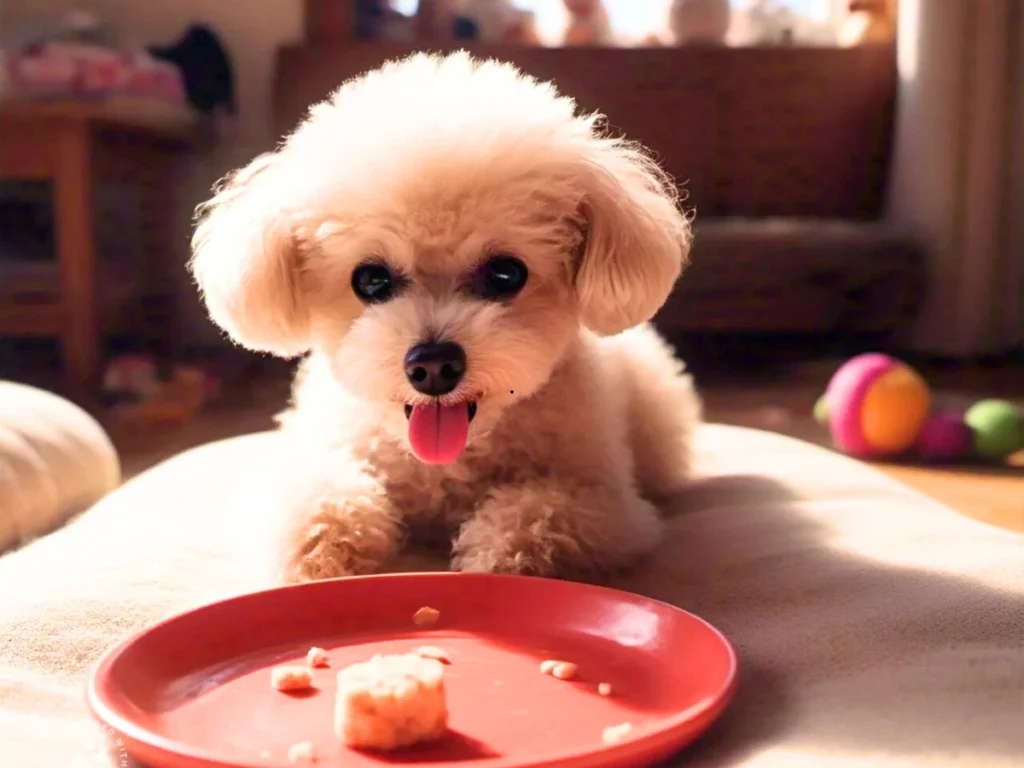
Following this toy poodle training and care guide for beginners will help establish a proper care routine.
Feeding Guidelines
- Puppies: 3-4 small meals daily
- Adults should consume 1/4 to 1/2 cup of high-quality dry food, divided into two meals.
- Fresh water is always available.
- Monitor weight to prevent obesity.
Can Toy Poodles Eat Certain Foods?
Toy poodles can eat various foods in moderation. Here are some common items:
- Rice: Yes, cooked rice can be a beneficial source of carbohydrates.
- Yes, you can feed apples, but you should remove the seeds and core before feeding.
- Carrots: Yes, they can be a healthy snack.
- Cheese can be consumed in small amounts as a treat.
- Peanut Butter: Yes, make sure it doesn’t contain xylitol, which is toxic to dogs.
- Pineapple: Yes, fresh pineapple is safe in moderation.
- Raw Meat: Consult with a vet before introducing raw meat to their diet, as it may carry health risks.
- Milk: In small amounts, some dogs can tolerate milk, but others may be lactose intolerant.
Feeding your toy poodle requires attention to their specific needs based on age and health. Monitor their weight and adjust food portions accordingly to prevent obesity. Always consult with a veterinarian for personalized dietary recommendations and before introducing new foods into their diet.
Exercise Needs
The toy poodle training and care guide for beginners recommends:
- 20-30 minutes of daily walks
- 15-20 minutes of interactive play
- Mental stimulation through puzzle toys
- Short training sessions
Daily Routine Guide
A common question in any toy poodle training and care guide for beginners is: “What is the daily routine of a toy poodle?” Here is a typical schedule:
Morning:
- Wake-up potty break.
- Morning meal
- Short walk or play session
- Rest period
Afternoon:
- Midday potty break.
- Interactive playtime
- Training session
- Rest period
Evening:
- Evening meal
- Longer walk
- Family interaction time
- Final potty break
Throughout the day:
- Regular bathroom breaks every 4-6 hours
- Access to fresh water
- Alternating activity and rest periods
- Social interaction with family
Grooming Requirements
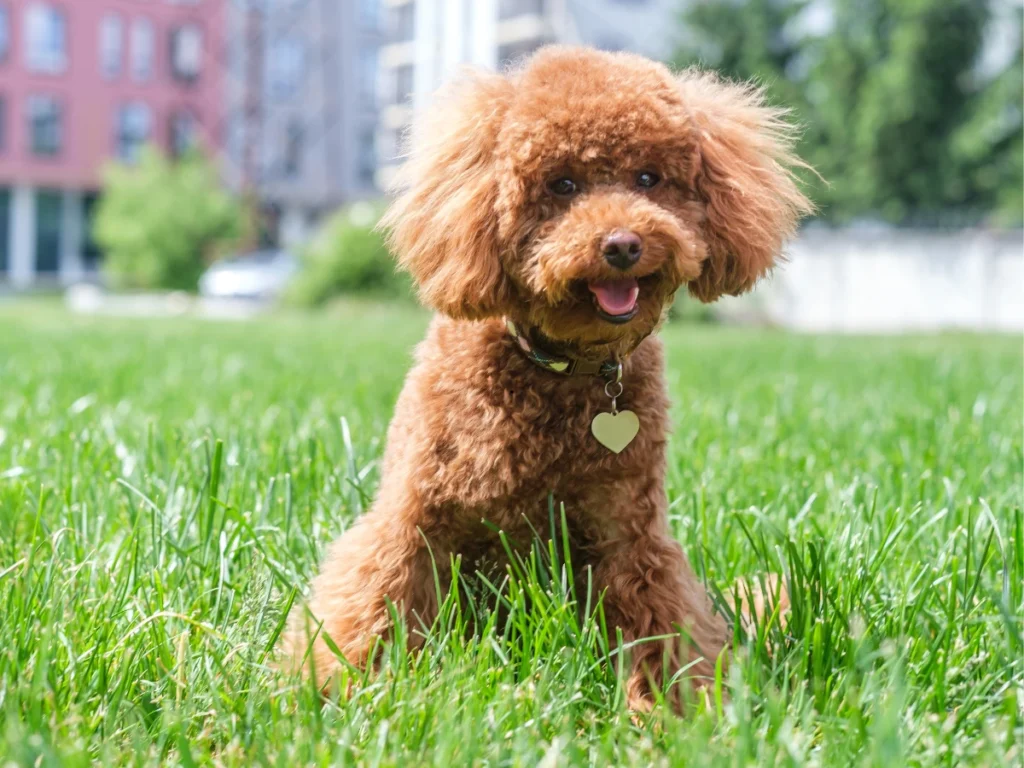
This section of the toy poodle training and care guide for beginners focuses on maintaining their signature appearance.
- Regular Grooming Schedule
- Daily brushing: 10 to 15 minutes
- Professional grooming: Every 4-6 weeks
- Nail trimming: Monthly or as needed
- Ear cleaning: Weekly
- Dental care: Daily
Professional Grooming Costs
- Full groom: $50-100 per session
- Special cuts/styling: Additional $20-40
- Bath and brush only: $30-50
Prices vary by:
- Location (urban areas cost more)
- Coat condition
- Style complexity
- Additional services are needed.
Complete Grooming Guide
This detailed section of the toy poodle training and care guide for beginners covers all aspects of grooming.
Basic grooming tools are needed.
- Professional-grade clippers
- Multiple blade sizes (#10, #15, #30)
- Slicker brush
- Metal comb
- Grooming scissors
- Nail clippers
- Ear cleaning solution
- Dog shampoo and conditioner
- Grooming table (recommended)
- Blow dryer
How to Groom a Toy Poodle: Step-by-Step Guide
Pre-Grooming Preparation
- Brush out all tangles.
- Bathe the dog thoroughly.
- Dry completely with a blow dryer.
- Set up a grooming area.
- Ensure all tools are clean and ready.
Basic Grooming Steps
- Start with a clean, dry coat.
- Remove any mats.
- Clip body in desired pattern
- Shape legs and face
- Clean ears and eyes
- Trim nails
- Final touch-ups
How to Cut a Toy Poodle’s Hair with Clippers
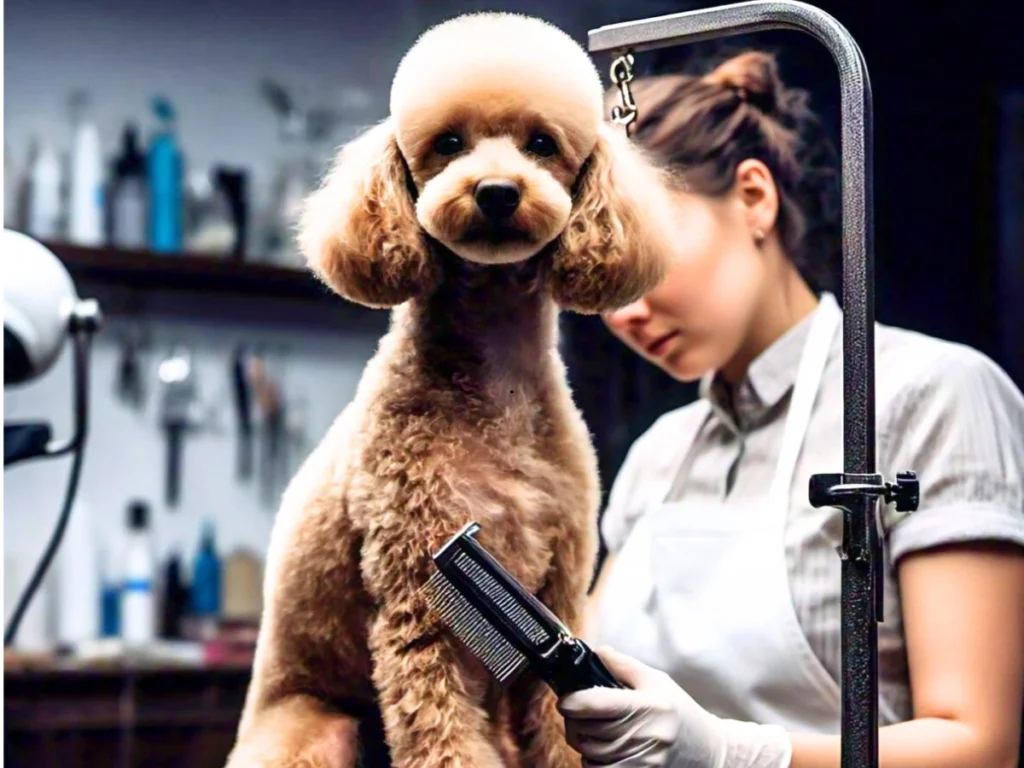
Getting Started
- Choose the appropriate blade size.
- Start with the body.
- Move in the direction of hair growth.
- Keep the blade flat against the skin.
- Work systematically
Detailed Clipping Guide
- Body: Use the #7 blade for a longer coat, or the #10 for a shorter one.
- Face: #10 blade for a clean face
- Feet: #30 blade for clean feet
- Tail: #10 blade for base
- Legs: Scissors for shaping
Professional vs. Home Grooming
What You Can Do at Home
- Daily brushing
- Basic maintenance clips
- Face cleaning
- Nail trimming
- Ear cleaning
When to See a Professional
- Full haircuts
- Pattern setting
- Show grooming
- Difficult areas
- Major mating
Common grooming mistakes to avoid.
- Cutting too short.
- Uneven clipping
- Wrong blade choice.
- Improper tool maintenance
- Rushing the process.
Seasonal Grooming Tips
Summer Care
- Shorter clips for comfort
- More frequent bathing
- Sun protection consideration
- Regular ear cleaning
Winter Care
- Longer coat maintenance
- Protection from elements
- Static control
- Paw pad care
Advanced Grooming Tips
Face Grooming
- Clean eye areas daily.
- Trim face every 2-3 weeks.
- Keep ears clean and plucked
- Watch for tear stains
- Regular teeth brushing
Feet and Nail Care
- Trim between paw pads
- Regular nail trimming
- Check for debris
- Monitor for injuries
- Keep feet clean and dry.
Health Considerations
Understanding health issues is crucial in any toy poodle training and care guide for beginners.
Common Health Issues
- Progressive Retinal Atrophy (PRA)
- Patellar Luxation
- Dental Problems
- Hip Dysplasia
- Von Willebrand’s Disease
Preventive Care
Your toy poodle training and care guide for beginners recommends:
- Regular veterinary check-ups
- Vaccination schedule adherence
- Dental cleaning maintenance
- Genetic testing, when recommended,
- Weight management
Advanced Training Tips
This toy poodle training and care guide for beginners includes advanced training techniques:
Mental Stimulation
Engage your toy poodle with a variety of mental challenges throughout the day to prevent boredom and maintain cognitive sharpness. Mix up activities to keep their highly intelligent minds engaged.
Puzzle toys
Introduce treat-dispensing toys and problem-solving games that reward your pet for figuring out solutions. Gradually increase difficulty levels as your toy poodle masters each puzzle.
Training games
Combine learning with play through hide-and-seek, fetch with specific toys, or following scent trails. These activities reinforce commands while making training enjoyable.
New command learning
Regularly introduce advanced commands and tricks to build upon basic training foundations. Break complex behaviors into smaller steps and reward progress consistently.
Agility exercises
Set up simple obstacle courses using household items to improve coordination and confidence. Start with basic movements and gradually advance to more challenging sequences.
Social interaction
Arrange supervised playdates with other dogs and expose your toy poodle to different people in various settings. Create positive experiences that build social confidence.
Behavioral Training
Address specific behaviors like excessive barking or separation anxiety through targeted training techniques. Focus on positive reinforcement while maintaining consistency in your expectations and responses.
The toy poodle training and care guide for beginners addresses common behaviors:
- Excessive barking management
- Separation anxiety prevention.
- Proper socialization techniques
- House training methods
- Leash training strategies
Complete Cost Guide for Toy Poodles
One of the most common questions in any toy poodle training and care guide for beginners is, “How much does a toy poodle cost?” Here is a comprehensive breakdown:
Purchase Price
The initial cost of a toy poodle varies based on several factors:
From Reputable Breeders
- Show quality: $3,000-$5,000
- Pet quality: $1,500-$3,000
- Basic registration: $1,000-$1,500
- Champion bloodline: $4,000-$6,000+
Factors Affecting Price
- Coat color: rare colors cost more.
- Pedigree
- Breeder reputation
- Geographic location
- Health testing
- Registration papers
Initial Setup Costs
First-time Expenses
- Veterinary check-up: $100-200
- Initial vaccinations: $100-300
- Microchipping: $45-55
- Spaying/neutering: $200-500
- Crate: $30-100
- Bed: $20-50
- Food/water bowls: $10-30
- Collar and leash: $20-40
- Initial toys: $30-50
- Grooming supplies: $100-200
- Training supplies: $50-100 Total initial setup: $705-1,625
Monthly Expenses
Regular monthly costs:
- Premium food: $30-50
- Treats: $10-20
- Grooming: $50-100
- Pet insurance: $30-60
- Toys replacement: $10-20
- Medical savings: $25-50
- Training classes: $50-100 (if needed)
- Total monthly: $205-400
Annual Expenses
Yearly costs include:
- Routine vet visits: $200-400
- Vaccinations: $100-200
- Dental cleaning: $300-700
- Professional grooming: $600-1,200
- Food and treats: $480-840
- Insurance: $360-720
- Licenses/registration: $10-30
- Emergency fund: $300-500
- Total annual: $2,350-4,590
Lifetime Cost Estimation
Based on a 12–15-year lifespan:
- Purchase price: $1,500-5,000
- Setup costs: $705-1,625
- Annual costs x 12-15 years: $28,200-68,850
- Emergency/unexpected costs: $2,000-5,000
- Total lifetime estimate: $32,405-80,475
Ways to Save Money
While maintaining quality care:
- Learn home grooming.
- Buy supplies in bulk
- Preventive healthcare
- Pet insurance is early.
- Regular vet check-ups
- DIY toys and treats Living Environment
The toy poodle training and care guide for beginners covers suitable living situations.
- Apartments
- Houses
- Urban settings
- Suburban environments
- Senior communities
- Life Stages Care
This toy poodle training and care guide for beginners breaks down care by life stage.
Puppy Stage (0-12 months)
- Frequent feeding (4-6 Meals)
- Intensive socialization
- Basic training
- Regular vet visits
- Proper vaccinations
Adult Stage (1-7 years)
- Established routines
- Regular maintenance
- Continued training
- Dental care
- Weight management
Senior Stage (8+ years)
- Modified exercise
- Health screenings
- Adjusted diet
- Comfort considerations
- Pain management, when needed.
Common Concerns
This toy poodle training and care guide for beginners addresses frequent concerns:
Temperament
- Highly intelligent
- Be affectionate with family.
- Alert and protective
- Sensitive to emotions
- Adaptable to new situations.
Training Challenges
- Separation anxiety
- Excessive barking
- House training
- Leash pulling
- Socialization issues
Special Considerations
The toy poodle training and care guide for beginners encompasses specific situations.
- Family Integration
- Good with older children.
- Supervision with young children
- Integration with other pets
- Family routine adjustment
- Establishing boundaries
Travel Preparations
- Carrier training
- Emergency supplies
- Identification requirements
- Accommodation planning
- Health certificates
Breeding Information: How often do toy poodles go into heat?
For those considering breeding, it’s important to understand Toy Poodle reproduction:
Heat Cycles
Female toy poodles typically go into heat every 6 months. The first heat usually occurs between 6 and 12 months of age. Heat cycles last approximately 2-4 weeks. Signs include behavioral changes and physical symptoms.
Breeding Considerations: How many times can a toy poodle get pregnant?
Before their second heat cycle, which usually occurs around 2 years of age, female Toy Poodles should not breed. We recommend limiting a female’s lifetime breeding to a maximum of 2-3 litters to protect her health. A minimum of one year between pregnancies is essential to allow full recovery. Breeding should stop by age 8.
A “litter” refers to a group of puppies born to a mother dog in a single pregnancy. For example, when a toy poodle gets pregnant and gives birth, all the puppies she delivers at that time are called a litter.
Here are some essential details about Toy Poodle litters:
A toy poodle typically has 3-4 puppies per litter on average. Some may have as few as 1-2 puppies or as many as 5-6 puppies in a single litter. Factors such as these can determine the size of the litter:
- The mother’s age and health
- The mother’s size
- Whether it’s her first pregnancy or a subsequent one,
- Genetics
Overall Health and Care during Pregnancy
Therefore, the term “2-3 litters maximum in a lifetime” refers to the recommendation that a female Toy Poodle should only become pregnant and give birth to puppies 2-3 times in her lifetime to maintain good health. However, professional veterinary guidance is essential for breeding.
Before breeding, we should complete health testing. Each pregnancy and the process of raising puppies (nursing them, caring for them) puts significant physical demands on the mother’s body.
Hence, it’s important to limit the number of times she breeds.
Making the Decision
Before bringing a Toy Poodle into your life, consider these factors:
Assessment Factors
The toy poodle training and care guide for beginners emphasizes evaluating your readiness through multiple key factors before bringing home a pet. These considerations ensure both owner and pet will thrive in their new relationship.
Time availability for care and attention
Your daily schedule must accommodate regular feeding, exercise, grooming, and training sessions as outlined in the toy poodle training and care guide for beginners. A toy poodle requires several hours of direct interaction each day to maintain their physical and emotional well-being.
Financial preparedness
Understanding and planning for both routine and emergency expenses proves essential for responsible pet ownership. The toy poodle training and care guide for beginners outlines costs including food, grooming, veterinary care, supplies, and potential medical emergencies.
Living space suitability
Your home environment should provide adequate space for exercise, play, and rest while keeping your pet safe and comfortable. Though toy poodles adapt well to various living situations, they need designated areas for activities and relaxation.
Family situation
Everyone in the household must agree to the responsibilities and adjustments that come with pet ownership. The toy poodle training and care guide for beginners stresses the importance of family cooperation in maintaining consistent rules and routines.
Long-term commitment capability
Bringing a toy poodle into your life represents a commitment spanning 12-15 years or more. This decision requires careful consideration of future life changes and your ability to provide consistent care throughout your pet’s lifetime.
Success Tips
This toy poodle training and care guide for beginners concludes with essential advice:
Maintain consistency
Creating and following a structured routine forms the backbone of successful toy poodle ownership. Regular feeding times, exercise schedules, and training sessions help your pet understand expectations and develop good habits.
Practice patience
Every toy poodle learns and adapts at their own unique pace, making patience essential for successful training and bonding. Rushing the process or showing frustration can create setbacks and anxiety in your pet.
Seek professional help when needed
Recognizing when to consult a professional trainer or veterinarian demonstrates responsible pet ownership and can prevent small issues from becoming major problems. Professional guidance provides valuable insights into your toy poodle’s behavior, health needs, and training challenges.
Join support communities
Connecting with other toy poodle owners through local clubs, online forums or social media groups creates a valuable network of shared experiences and advice. These communities provide emotional support, practical tips, and opportunities for socialization.
Document progress
Keeping a record of your toy poodle’s development helps track important milestones, health information, and behavioral changes over time. Photos, videos, and written notes create a valuable reference for monitoring growth, identifying patterns, and sharing information with veterinarians or trainers.
Frequently Asked Questions
| Why Are Poodles So Clingy? | Poodles, including Toy Poodles, are known to be very affectionate dogs. They love being close to their owners. |
| Are Poodles Anxious? | Toy Poodles can sometimes show signs of anxiety, especially when left alone for long periods. |
| Are Poodles Vocal? | Toy Poodles are generally not overly vocal, but they will bark when something catches their attention. |
| When Do Poodles Calm Down? | Poodles, including Toy Poodles, are generally energetic dogs. They often start to calm down around 2 to 3 years of age. |
| Are Toy Poodles Smart Dogs? | Yes, Toy Poodles are one of the most intelligent dog breeds, they quickly learn commands and exhibit a strong desire to please. |
| Why Were Toy Poodles Bred? | Originally, aristocrats bred Toy Poodles as companion dogs. Their small size made them simple to keep indoors, while their intelligence and trainability ensured they were delightful companions. |
| Are Toy Poodles Good Family Dogs? | Yes, Toy Poodles are excellent family dogs. Their gentle temperament, affectionate nature, and adaptability make them ideal for families of all sizes. |
| Are toy poodles good for kids? | Toy Poodles are generally simpatico with children, especially older ones who know how to interact gently but their small size necessitates supervision with younger kids. |
| Can Poodles Have Blue Eyes? | Yes, Poodles can have blue eyes, but this is rare and typically associated with specific coat patterns such as merle. |
| Can Poodles Get Fleas? | Yes, like all dogs, Poodles are susceptible to fleas. Regular grooming and preventative care can help keep them flea-free. |
| What is a merle poodle? | Though not recognized by all breed standards, a merle Poodle has a unique coat pattern with mottled patches of color. |
| Can Poodles Be Merle? | Yes, some Poodles can have the merle coat pattern, but it is rare. |
| What is a Moyen Poodle? | A Moyen Poodle is a medium-sized Poodle, larger than a Miniature but smaller than a Standard Poodle. |
| Are Parti Poodles More Expensive? | No, pink poodles are not naturally occurring; they are often created through temporary dyeing for fun or show purposes. |
| Are Poodles skinny? | Poodles are naturally slim and athletic, but they should maintain a healthy weight for their size. |
| Are Poodles Loyal? | Absolutely! Poodles are known for their loyalty and strong bonds with their families. |
| Are Poodles Territorial? | They can be territorial and protective, especially with strangers, making them alert watchdogs. |
| Can Poodles Be Service Dogs? | Yes, Poodles, including Toy Poodles, can be trained as service dogs due to their intelligence and trainability. |
Conclusion
This toy poodle training and care guide for beginners establishes a strong foundation for success with your new companion. The comprehensive advice helps both new and experienced owners understand essential aspects of daily routines, health management, and training techniques. Each section of this toy poodle training and care guide for beginners recognizes that every dog develops its own distinct personality and specific needs.
Your dog requires adjustments to these guidelines based on individual factors such as temperament, health status, and home environment. The care patterns presented in this toy poodle training and care guide for beginners must adapt as your pet grows from an energetic puppy into a mature adult and eventually becomes a senior companion. A patient approach combined with steady routines and abundant positive reinforcement builds lasting trust and cooperation.
Working with professional trainers and joining poodle communities adds valuable support to your journey. These resources provide real-world experience and practical solutions for common challenges. Regular interaction with other toy poodle owners helps you learn new techniques and stay motivated during training. The investment you make in understanding and meeting your dog’s needs through this toy poodle training and care guide for beginners pays dividends through years of companionship.
The path to creating a deep bond takes dedication, but the rewards make every effort worthwhile. Your consistent care and attention transform a toy poodle into more than just a pet – you gain a loyal, intelligent, and affectionate family member. When you celebrate small achievements and remain focused on progress rather than perfection, both you and your toy poodle thrive together. This partnership, built on proper training and attentive care, enriches your life with joy and companionship for many years to come.
However, If you are also interested in a cross breed of poodles with that of German Shepherds known as Shepadoodle then here is another amazing read which contains all the information that you want have about this unique breed: German Shepherd Poodle Mix: 16 Essential Facts to Exceptional Shepadoodle


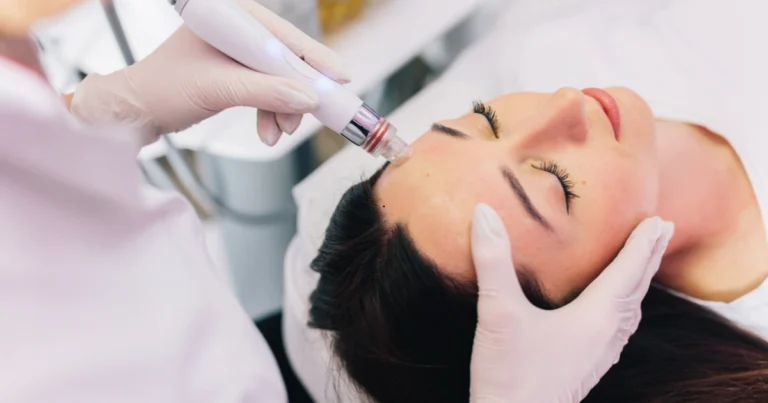
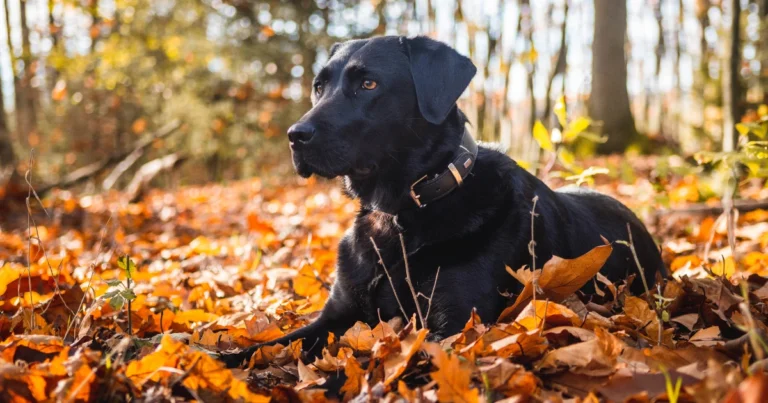
Leave a Reply